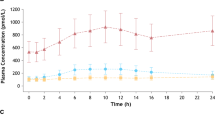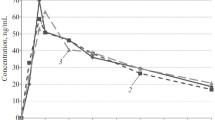Summary
The plasma concentrations of free α-methyldopa and methyldopa sulphate conjugate were measured in 7 hypertensive patients with normal renal function following α-methyldopa (1 g) orally. Five of these patients subsequently received α-methyldopa ethyl ester (250 mg) (methyldopate) intravenously and two further patients received 250 mg of α-methyldopa intravenously. After oral administration a large amount of total plasma α-methyldopa was present as sulphate conjugate. There were wide interindividual differences in the ratio of free: conjugated α-methyldopa in plasma (ratio at 4 hours ranged from 3.73 – 0.83) suggesting that individual differences in the extent of sulphate conjugation may occur. There was no close correlation between the degree of conjugation and the fall in arterial pressure. At all time intervals examined, plasma concentrations were higher following intravenous α-methyldopa than α-methyldopate. The plasma concentration of α-methyldopa (free and esterified) 60 minutes after i.v. α-methyldopate was 1.7±0.3 µg/ml wile at the same time after the same dose of methyldopa by the same route the mean concentration was 5.9 µg/ml. Although small amounts of sulphate conjugate were detected after i.v. α-methyldopate, insignificant quantities of conjugate were found after i.v. α-methyldopa. The average fall in mean arterial pressure was 27 mm Hg following i.v. α-methyldopa but only 2.7 mm Hg following α-methyldopate. These results suggest that sulphate conjugation of α-methyldopa occurs in the gastrointestinal tract during absorption. Hydrolysis of α-methyldopa ethyl ester does not appear to be instantaneous and pharmacokinetic differences between the ester and free α-methyldopa have been demonstrated.
Similar content being viewed by others
References
Oates, J.A., Gillespie, L., Udenfriend, S., Sjoerdsma, A.: Decarboxylase inhibition and blood pressure reduction by α-methyl-3,4-dihydroxy-DL-phenylalanine. Science131 1890–1891 (1960)
Sourkes, T.L., Murphy, G.F., Chavez-Lara, B.: A metabolic study of α-methyl-β-(3,4-dihydroxy-phenyl)-DL alanine in man. J. Med. Pharm. Chem.5 204–210 (1962)
Gillespie, L., Oates, J.A., Crout, J.R., Sjoerdsma, A.: Clinical and chemical studies with α-methyldopa in patients with hypertension. Circulation25 281–291 (1962)
Sjoerdsma, A., Vendsalu, A., Engelman, K.: Studies on the metabolism and mechanism of action of methyldopa. Circulation28 492–502 (1963)
Prescott, L.F., Buhs, R.P., Beattie, J.O., Speth, O.C., Trenner, N.R., Lasagna, L.: Combined clinical and metabolic study of the effects of alpha methyldopa on hypertensive patients. Circulation34 308–321 (1966)
Dollery, C.T., Harington, M.: Methyldopa in hypertension: clinical and pharmacological studies. Lancet1962 I 759–763
Au, W.Y.U., Dring, L.G., Grahame-Smith, D.G. Isaac, P., Williams, R.T.: The metabolism of14C labelled α-methyldopa in normal and hypertensive human subjects. Biochem. J.129 1–10 (1972)
Buhs, R.P., Beck, J.L., Speth, O.C., Smith, J.L., Trenner, N.R., Cannon, P.J., Laragh, J.H.: Metabolism of methyldopa in hypertensive human subjects. J. Pharmacol. exp. Ther.143 205–214 (1964)
Roy, A.B.: The synthesis and hydrolysis of sulfate esters. Advanc. Enzymol.22 205–235 (1960)
Conolly, M.E., Davies, D.S., Dollery, C.T., Morgan, C.D., Paterson, J.W., Sandler, M.: Metabolism of isoprenaline in dog and man. Brit. J. Pharmacol.46 458–472 (1972)
Anton, A.H., Sayre, D.F.: Study of the factors affecting the aluminium oxide-trihydroxy-indole procedure for the analysis of catecholamines. J. Pharmacol. exp. Ther.138 360–375 (1962)
Laverty, R., Taylor, K.M.: The fluorometric assay of catecholamine and related compounds. Improvement and extension of the hydroxy-indole technique. Ann. Biochem.22 269–297 (1962)
Rowland, M.: Influence of route of administration on drug availability. J. pharm. Sci.61 70–74 (1972)
Stenbaek, O., Myhre, E., Brodwall, E.K., Hansen, T.: Hypotensive effect of methyldopa in renal failure associated with hypertension. Acta. med. scand.191 333–337 (1972)
Schrader, K., Brass, H., Renner, D.: Zur Pharmacokinetik von α-Methyldopa bei Niereninsuffizienz. Klin. Wschr.49 1329–1334 (1971)
Henning, M.: Studies on the mode of action of α-methyldopa. Acta physiol. scand. Suppl.322 1–37 (1969)
Finch, L., Haeusler, G.: Further evidence for a central hypotensive action of alpha methyldopa. Brit. J. Pharmacol.45 167–168 P (1972)
Author information
Authors and Affiliations
Rights and permissions
About this article
Cite this article
Saavedra, J.A., Reid, J.L., Jordan, W. et al. Plasma concentration of α-methyldopa and sulphate conjugate after oral administration of methyldopa and intravenous administration of methyldopa and methyldopa hydrochloride ethyl ester. Eur J Clin Pharmacol 8, 381–386 (1975). https://doi.org/10.1007/BF00562310
Received:
Revised:
Accepted:
Issue Date:
DOI: https://doi.org/10.1007/BF00562310




